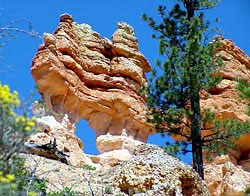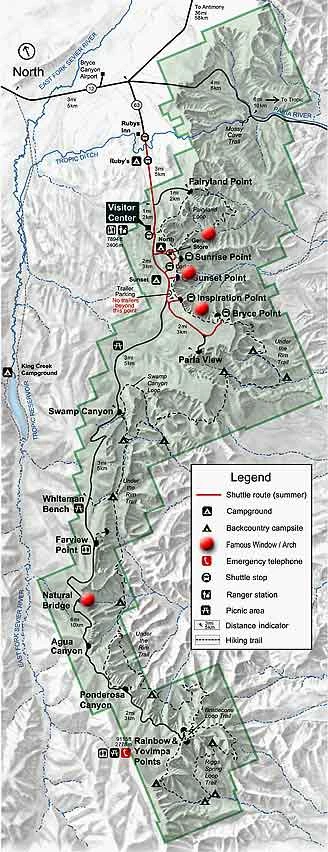|
Common Name (preferred): Arches Geologic Name: Windows Size Range: 3-60 ft. (1-19m) in diameter Formation Name: Claron Formation Rock Age: Most common in sedimentary rock. At Bryce often seen in the Limestone of the Claron Formation. Famous Examples: Natural Bridge & Wall of Windows 
nps Windows or arches are natural holes that form along cracks and weak spots in thin walls of rock called "fins." By convention these holes must be at least 3 feet in diameter in two perpendicular directions to earn the name arch or window. An imprecise distinction is often made between bridges and arches in terms of the processes that form them. It's important to remember that gravity is the key factor in either case. Nevertheless, the distinction is that bridges are carved by flowing water, whereas arches can be carved by everything else except flowing water. Indeed, in very few circumstances is it possible to say that flowing water had zero contribution in the development of one of these natural holes. Therefore, geologists often prefer the term window to collectively describe any large hole in a rock. At Bryce Canyon most of our windows are carved by frost wedging. Formational Process: 
Weathering and erosion carve through these cracks steadily widening them, opening up slot canyons, leaving behind walls or fins in-between. The primary weathering force at Bryce Canyon is frost wedging. Here we experience over 200 freeze/thaw cycles each year. In the winter, melting snow in the form of water, seeps into the cracks and refreezes at night. When water freezes it expands by almost 10%, bit by bit, forcing the cracks wider and wider in the same way a pothole forms in a road. At the same time this process is converting ridges into fins, it is also forming windows along the perpendicular fractures within individual fins. Once a window becomes too large to support its own roof it will collapse leaving one leg of the window standing detached - thus creating a hoodoo. Preservation Message: When and where to see at Bryce: 
Further Reading: Ritter, Dale F. Kochel, R. Craig. Miller, Jerry R. 1995. Process Geomorphology 3rd edition. Wm. C. Brown Publishers. 365-66. Sprinkel, Chidsey, & Andersons (eds) 2000. Geology of Utah's Parks and Monuments. Utah Geological Association. Bryce Canyon Natural History Association, Bryce Canyon, Utah |
Last updated: February 24, 2015
